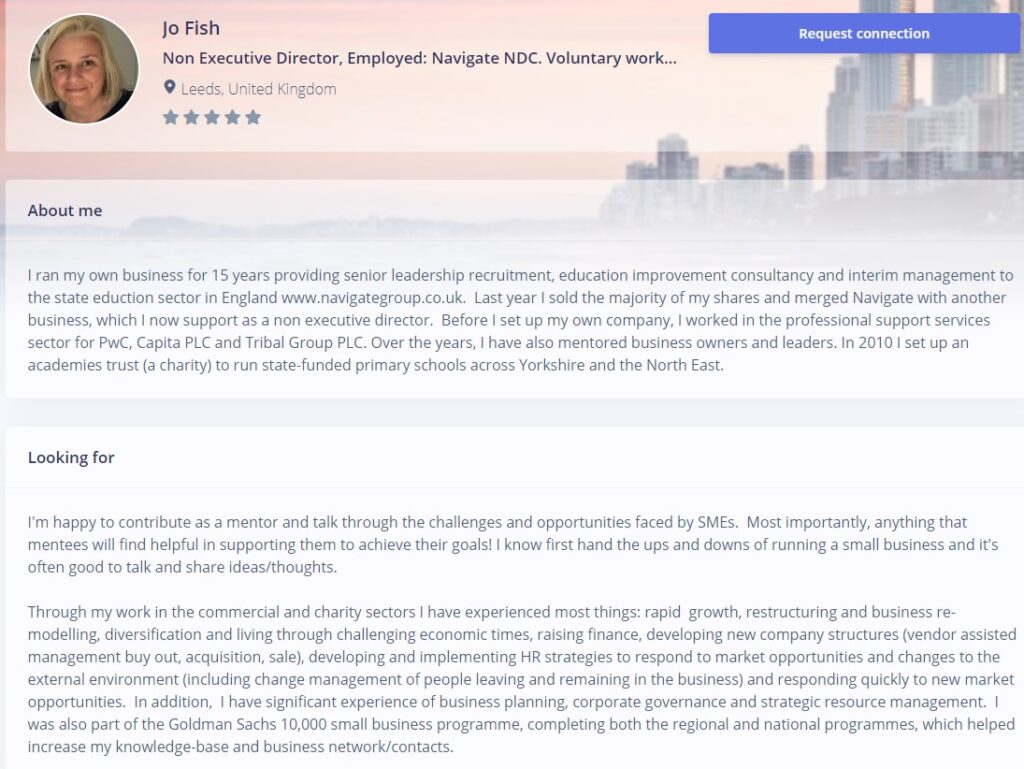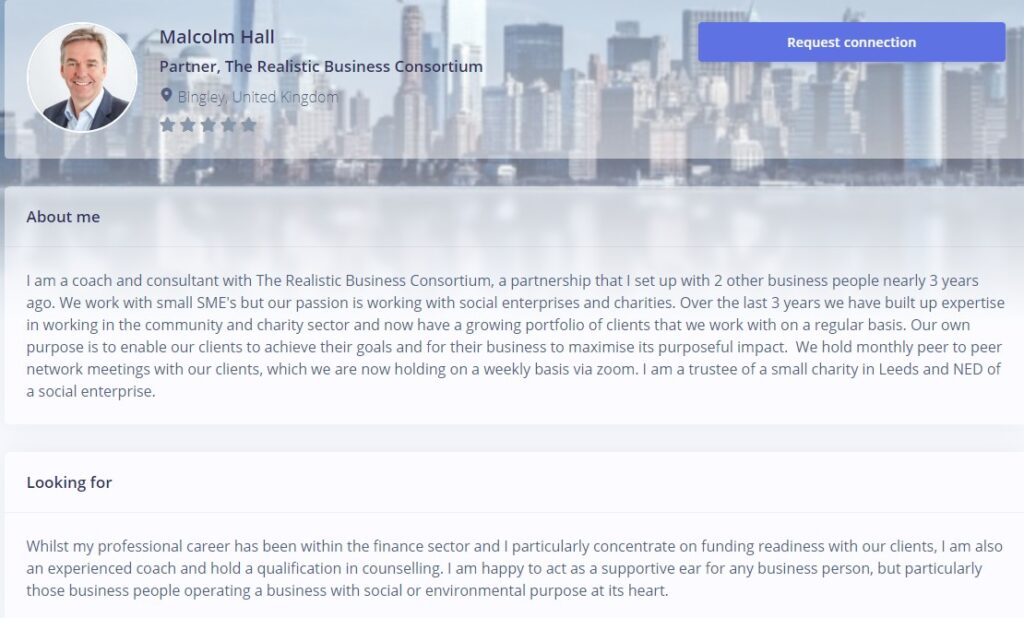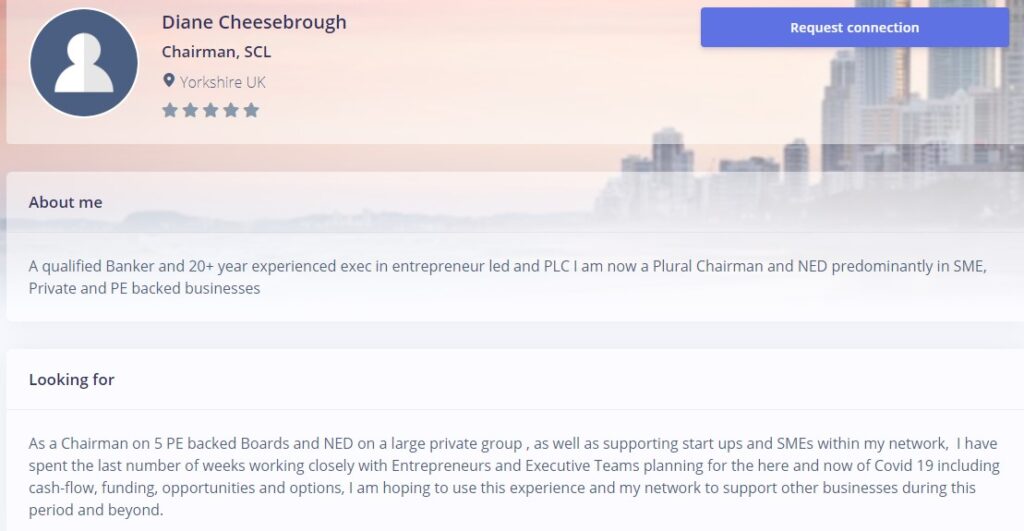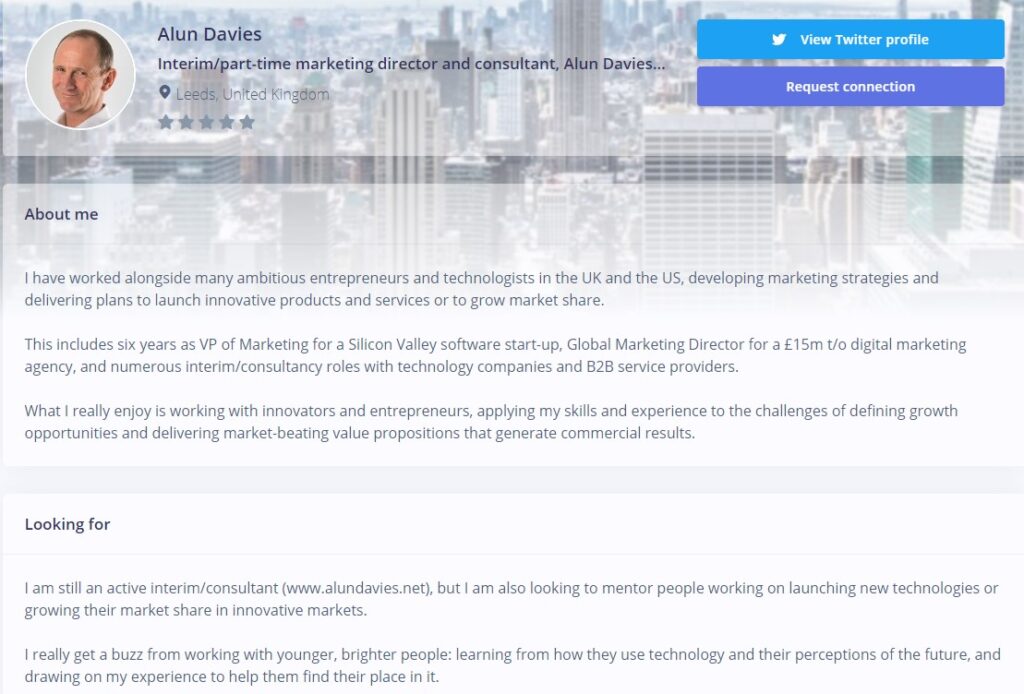7 tips to write a profile for mentoring/non-executive director roles!
1 April 2020 By Victoria Tomlinson

Thanks to the dozens of people who have signed up to be mentors to entrepreneurs and leaders – of any sector – in these challenging times (if you want to know more – go to www.next-up.com and click on the 500 mentors popup).
We have fantastic people offering help. But most have copied and pasted their LinkedIn profile or CV on here. Just as we launched this campaign quickly, so others are signing up quickly and many have said they will go back and refine when they have a minute.
But I know filling in your profile can cause a huge amount of angst! So this blog is to help you fill in the box – and in the process make it so appealing that people will want to contact you.
And below I have picked out a few Next-Up mentor profiles that I think will be working well to interest mentees, as examples.
These tips are written specifically for our 500 mentors campaign to make it easy for mentees to approach you. But the points I cover are relevant to LinkedIn and any online platforms if you are looking for non-executive director or other roles – and some also apply to your CV.
1. Understand how online sites work
First of all, you need to think about how all online ‘matching’ sites work.
In the case of LinkedIn, headhunters put in keywords when they are searching for people in specific roles. So they might type in
- Non-executive director/chair
- Governance
- International markets
- AI (artificial intelligence)
- Start-ups
Clearly LinkedIn is only going to show people who have these words or very similar included in their LinkedIn profile. The search is done mainly on your professional headline (people think of this as their job title) and the About section. Your Experience section with details about your roles is much less important, so don’t rely on this.
Our mentoring site also works using artificial intelligence. Like most sites, the more people who sign up, the more information and the more matching that happens, so the quality of the matching will improve. As I write, our site is not even a week old so this will take time!
However, the algorithm is based on
- Matching words that the mentor uses in their experience, to the words that the mentees are saying they want help with. As well as similarities in their profiles
- Over time, it will also look for similarities between the types of people who are connecting to each other and make similar suggestions for other connections
2. Think about the person you are targeting
Long before you start writing about yourself, think about the person you are targeting – whether that is an individual wanting a mentor or a chairman looking for a non-executive director or trustee.
What are the issues they are facing? For a non-exec role, you can do research – look at annual reports, news coverage, speak to contacts who have been involved with them.
If we take our mentoring site, the mentees you want to help could be entrepreneurs – tech, social or other, business leaders, leaders of voluntary and public sector organisations. The 500 mentors campaign is focused on helping people through the COVID-19 crisis in particular – though there is no reason you can’t continue this once this is over.
So, what might the mentee be thinking or worrying about
- I’ve got so many priorities, I don’t know where to start
- I have had to change my management style – I’ve suddenly become command and control, am I getting it right
- I’m worried about missing key things
- How on earth do I manage cashflow when I don’t know how long we are in this for
- How do I keep my teams motivated remotely?
- There are opportunities out there, where do I start
- I daren’t tell anyone this, but I am really excited. I think things are going to be so different and I want to be part of that
- We were about to start fundraising. Should I still go ahead, who should I talk to
- Could I get more services online – is it worth investing if we are back to normal in June
- What should I get in place now for when things get back to normal?
- I’m running out of steam, I’m getting crabby – how do I manage this
- How much should I share with my team – especially if you work in a small team
These are my thoughts from talking widely to entrepreneurs and leaders at the moment – but you will have your own thoughts and had your own conversations.
3. Match your experience and skills to the need
Once you have your head in the ‘other side’, now is the time to think about your experience and give examples that would be relevant. For instance
- If you have been an HR director, you might want to talk about having had to lay off 200 people in the recession and things you learnt to be compassionate; or having to recruit hundreds of people at short notice for new projects; or moving people from one department into new areas and training in new skills at speed
- If you can help with fundraising, talk about the types of businesses you have helped, the networks you currently have and who is still lending to what types of start-ups/scale-ups and the introductions you can help with
- You might talk about how you are good at helping people to think of new opportunities when things feel hopeless
- Or just that you are a good listening ear if it would help to talk things through
- If you have been a mentor, it’s worth mentioning. There is a danger when people mentor for the first time that they slip into talking about themselves too much rather than asking questions and listening
4. Be human on social media site
The language on social media – LinkedIn, our mentoring site, Twitter – is far more conversational than most professionals are used to (this doesn’t apply to CVs which are still formal, brief and written in the third person).
If you can write in a conversational style, this tends to be engaging and give you personality. This is not to be long-winded, however!
5. Include a photo
A lot of people struggle with photos! They don’t like what they have, only have holiday snaps, can’t remember where they saved the photo they did like or are not sure how to upload.
My tips on this are
- Brush your hair, put on lippy – if applicable, smile and get a friend or family to take a photo on your phone
- Press share on the photo and email it to yourself, reduced size image is fine
- Save it on the desktop of your laptop or PC or save it on your phone somewhere you can access it easily and remember it (save the photo on whichever device you are most likely to use for completing a profile so you can always find it easily)
- When you are asked for a photo to go into any profile, just click ‘Browse’ and go to that photo and upload
Having a photo makes a world of difference to help people get to know you and want to work with you. It should be a head and shoulders, look professional though doesn’t have to be in a suit – and make sure you can see your face. Don’t have hats or goggles that make it difficult to see you
6. Tailor your profile and information to each site or role
Tailoring your profile sounds so obvious, but very few people do this. I think people spend so long creating their CV originally that mentally they feel, “Phew, that’s done” and then use the same wording everywhere.
This won’t work for our mentoring site or for non-executive director roles. It doesn’t have to be time-consuming – four or five paragraphs on our Next-Up mentoring site will be fine. Just make them relevant.
7. Your job title
When a site asks for your job title this can be challenging when you don’t have a specific role. Some suggestions as to what you might say
- Mentor
- Board/charity adviser or just ‘adviser’
- Non-executive director/trustee
- Consultant
Some people put ‘former’ in here – it can work, but probably having something as above is better.
We are so grateful for the generosity of everyone who has signed up to offer their help as mentors. And we hope that by getting involved, opportunities will come out of this for you in the long term – new networks, new ideas and new activities.
GOOD EXAMPLES OF MENTOR PROFILES (my personal view!)





Other blogs that might help you are
How to write LinkedIn content that will win you business or roles
8 LinkedIn essentials for a winning (unretirement) profiles
Golden nuggets to write a winning CV for unretirement
10 tips for mentoring in COVID-19 times
Can a non-techie mentor a tech entrepreneur? Yes, absolutely!


